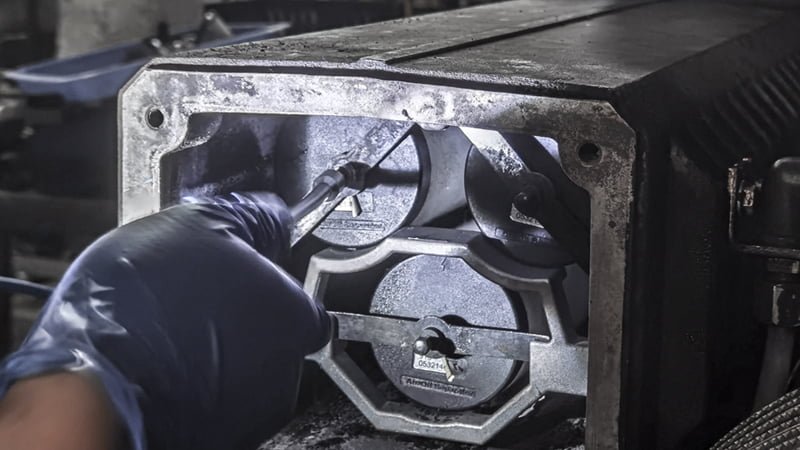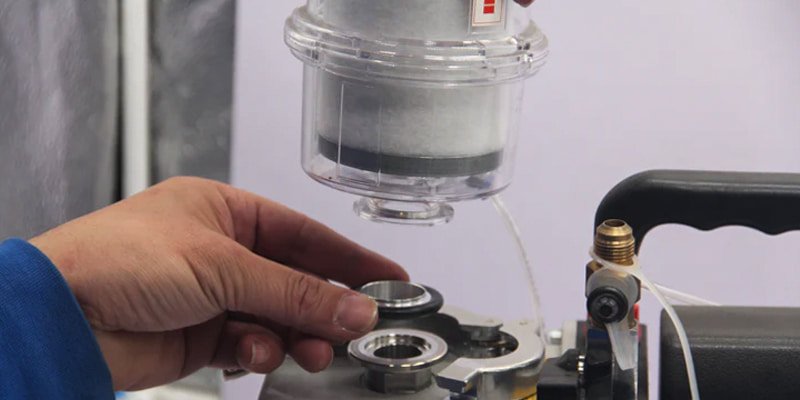Your pump seems slow and noisy, and you can't hit the vacuum levels you need. This frustration costs you time and money, and you're worried the pump itself is failing.
Yes, a dirty or clogged filter is a very common cause of poor vacuum pump performance. It restricts airflow, forcing the pump to work harder, which leads to overheating, reduced vacuum levels, increased noise, and potential contamination of the pump oil.

A vacuum pump is the heart of your system, but the filters are its lungs. If the lungs can't breathe, the heart can't perform. In my 10 years of helping clients with their vacuum systems, I've seen expensive pumps replaced when the real problem was just a ten-dollar filter. It's the simplest part of the system, but neglecting it can cause the biggest headaches. Let's walk through how to keep your filters in top shape so your pump can perform at its best.
How Do You Know When a Filter Element Needs to Be Changed?
You can't see inside the filter housing. Changing it too often wastes money, but waiting too long can damage your pump. Knowing the signs is key to perfect timing.
You'll know a filter needs changing by observing specific performance drops: the pump takes longer to reach the target vacuum, it runs louder than usual, or a differential pressure gauge indicates a significant pressure drop across the filter housing.

Your vacuum pump will give you clear signals when its filter is struggling. You just need to know what to look for. Ignoring these signs is like ignoring your car's check engine light—it usually leads to bigger problems down the road.
Performance-Based Indicators
The easiest way to tell is by paying attention to your process.
- Slower Pump-Down Time: If your chamber used to reach its target vacuum in five minutes, but now it's taking ten, a clogged filter is the most likely culprit. The restricted airflow is bottlenecking the whole system.
- Increased Operating Noise: A pump straining against a blocked filter will often sound different. It might have a higher-pitched whine or a louder, more labored hum.
- Pump Overheating: If the pump body feels hotter than normal, it's working too hard. A clogged filter is a primary cause of this strain.
Instrument-Based Indicators
For a more precise method, look at the gauges. Many filter housings are equipped with a differential pressure gauge. This tool measures the pressure difference between the inlet and outlet of the filter. As the filter clogs, this pressure difference increases. When the needle enters the red zone, it's a clear, data-driven signal to change the element.
| Indicator Method | Pro | Con |
|---|---|---|
| Performance | No special tools needed | Subjective, requires consistent process |
| Instrumentation | Precise and reliable | Requires a differential pressure gauge |
| Scheduled | Proactive, prevents issues | May change filters too early/late |
How Do You Change a Vacuum Pump Filter Step-by-Step?
It might seem like a simple swap, but a mistake can introduce leaks. Doing it wrong can create new problems. Following a clear procedure ensures a perfect, leak-free seal every time.
To change a filter, first safely shut down and isolate the pump. Then, carefully open the filter housing, replace the old element with the new one, inspect and clean the O-ring seal, and securely reassemble the housing.

Changing a filter is a routine maintenance task that you can easily do yourself. I've done it hundreds of times. The key is to be careful and methodical.
Step 1: Safety First
Before you touch any tools, ensure your safety. Power down the entire system and use a lock-out/tag-out procedure to prevent it from being accidentally started. Vent the pump to atmospheric pressure. If the pump is hot, let it cool down to a safe temperature.
Step 2: Open the Housing
Most filter housings are held on with bolts or a single large retaining nut. Loosen these evenly to open the housing. Be prepared with a rag or a small pan underneath, especially for an oil mist filter, as some residual oil will likely drip out. Once open, remove the old, dirty filter element.
Step 3: Clean and Inspect
This step is critical and often skipped. Wipe the inside of the filter housing clean. Most importantly, carefully remove the O-ring or gasket that seals the housing. Inspect it for any nicks, cracks, or flat spots. If it shows any signs of wear, replace it. A damaged O-ring is the number one cause of leaks after a filter change.
Step 4: Install and Reassemble
Place the new filter element into the clean housing. Re-seat the new or inspected O-ring in its groove. Then, close the housing and tighten the bolts. If there are multiple bolts, tighten them in a star pattern to ensure the pressure is applied evenly, just like changing a tire. This prevents warping the flange and ensures a good seal.
Can You Clean a Vacuum Filter Instead of Replacing It?
Buying new filters adds up over time. You might be wondering if you can just clean and reuse the old one to save a bit of money and reduce waste.
Yes, some pleated, paper-style inlet filters for coarse filtration can be temporarily cleaned with low-pressure compressed air. However, oil mist filters and other fine media filters must always be replaced, not cleaned, to ensure proper function and safety.

This is a question I get a lot from my clients. The answer is, "it depends." As an insight from my experience, cleaning can work for certain types, but it's a huge mistake for others.
What You Can Clean
The only filters you should ever consider cleaning are inlet filters designed to catch large, dry particles. These are often made of a pleated paper or polyester mesh. You can extend their life a bit with a gentle cleaning.
- The Method: Use low-pressure compressed air.
- The Technique: Blow the air from the clean side of the filter through to the dirty side. This pushes the trapped particles back out the way they came. Never use high pressure, as it will create tiny tears in the filter media, making it useless.
What You Must Replace
You must never attempt to clean an oil mist eliminator filter (also called an exhaust filter). These filters are designed to capture a very fine aerosol of oil. The oil saturates the deep filter media. Trying to blow it out with air is impossible and will damage the delicate fibers. A damaged exhaust filter will spew oil mist into your workshop, creating a slippery, hazardous breathing environment. Always replace these filters—the cost is minor compared to the risk.
What Happens If You Don't Change Your Vacuum Filter?
It's just a filter, so what's the worst that could happen? Ignoring it seems easier in the short term, but the consequences of neglect can be severe and expensive.
Neglecting a filter leads to reduced vacuum performance, pump overheating, and oil contamination. This ultimately causes catastrophic failure of pump components like bearings and vanes, resulting in costly repairs and extended downtime.

Letting a filter go for too long is one of the most expensive "small" mistakes you can make. The problems start small but quickly cascade into a total system failure.
The Downward Spiral of Neglect
First, your performance drops. The pump has to work much harder to pull air through the clogged filter, leading to inefficiency and higher energy bills. This extra strain generates excess heat. This heat is the enemy of your pump oil. It causes the oil to break down and degrade, losing its ability to lubricate properly. The degraded oil turns into sludge, which clogs oil lines and starves critical components of lubrication.
Catastrophic Failure
This is the end game. The pump's bearings, now running hot and without proper lubrication, will seize up. The vanes can chip or break. I have seen pumps come into the shop where the internals are completely destroyed, all because of a filter that wasn't changed. A major pump rebuild or a full replacement can cost thousands of dollars. Compare that to the small price of a new filter. The choice is obvious. Don't wait for the failure to happen.
Closing Summary
Regularly checking and changing your pump's filters is the cheapest and easiest way to guarantee long-term performance. This simple act of maintenance prevents costly repairs and keeps your system running smoothly.


